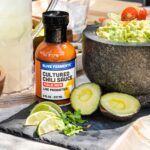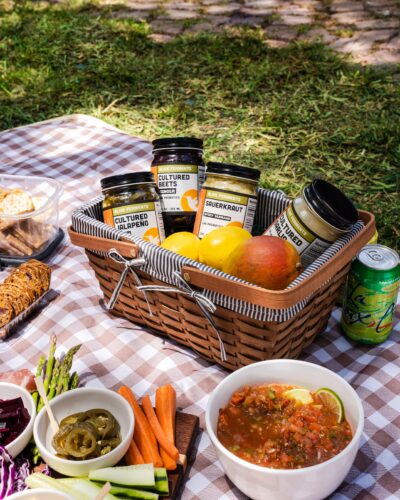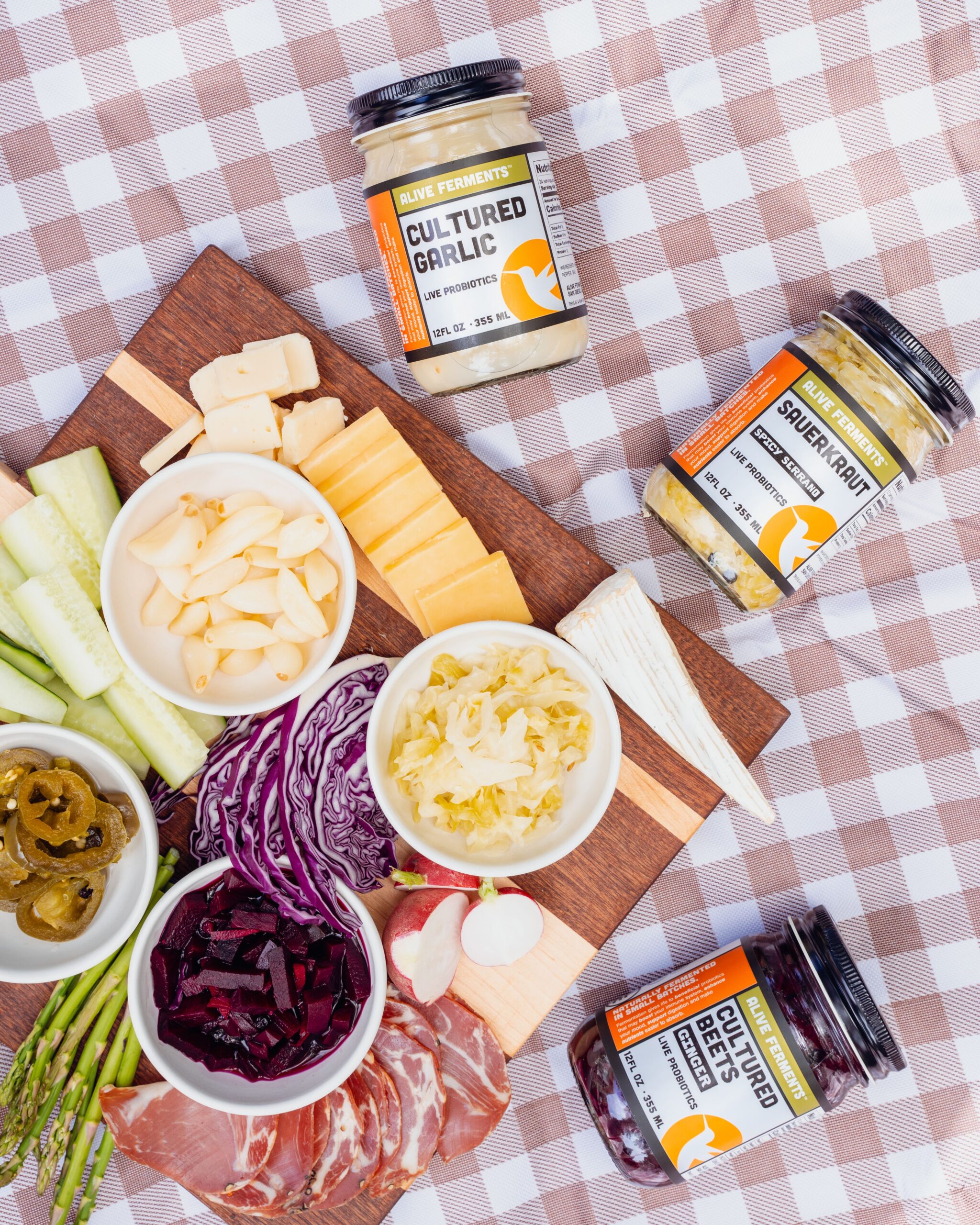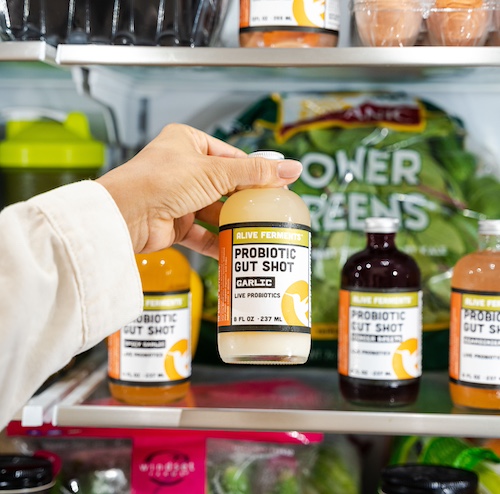
Probiotic Guacamole
September 1, 2024Fermentation is an ancient food preservation technique that has experienced a resurgence in popularity due to its numerous health benefits and unique flavors. Whether you're new to fermenting or looking to expand your repertoire, we’re here to provide you with essential information and delicious lacto-fermented recipes to get you started.
More specifically, we’ve made free, downloadable recipes for fermented sauerkraut, fermented giardiniera, fermented chili sauce, and fermented garlic that you can make in the comfort of your own home.
Want to see how your creations stack up to the professionals? Don’t have the time to wait for your homemade jars to ferment? Order a bottle of Alive Ferments hot sauce or fermented vegetables today for a satisfying punch of flavor and gut-healthy goodness, heat optional. Without further ado, let’s dive in!
Pickled vs. Fermented: What’s the Difference?
While both pickling and fermenting are preservation methods that can create delicious, tangy foods, they involve different processes and offer distinct benefits. Let's explore the key differences:
Pickled Recipes
Pickling is a preservation method that involves submerging foods in an acidic solution. Here are some key points about pickling:
- Process: Foods are preserved in a pre-made acidic solution, typically a mixture of water and vinegar, with added salt and spices.
- Acidity: The acidic environment is created instantly by adding vinegar or other acids.
- Bacterial activity: The high acidity typically prevents bacterial growth, including beneficial bacteria.
- Shelf stability: Pickled foods are often heat-processed for long-term shelf stability.
- Nutrition: While still nutritious, pickled foods may lose some nutrients during the process.
Lacto-Fermented Recipes
Fermentation is a natural process where beneficial bacteria convert sugars in food into lactic acid. Here's what you need to know about fermenting:
- Process: Foods are submerged in saltwater brine or dry-salted, allowing naturally present bacteria to thrive.
- Acidity: The acidic environment develops gradually as bacteria produce lactic acid.
- Bacterial activity: Beneficial bacteria, particularly lactobacillus, are encouraged to grow.
- Shelf stability: Fermented foods are typically stored in the refrigerator to slow down the fermentation process and are not heat-processed to keep beneficial bacteria alive.
- Nutrition: Fermentation can enhance the nutritional value of foods and create probiotics.
More on Lacto-Fermentation
Lacto-fermentation is a process where beneficial bacteria convert sugars in food into lactic acid. This natural preservation method creates an environment that inhibits harmful bacteria while promoting the growth of probiotics. Many fermented recipes, including our lacto-fermented recipes, rely on this process to create delicious and nutritious foods.
Health Benefits of Fermented Foods

Research shows that consuming fermented foods can offer numerous health advantages:
- Improved digestion
- Enhanced nutrient absorption
- Strengthened immune system
- Potential mood and mental health improvements
A Stanford University study found that a diet rich in fermented foods can increase gut microbiome diversity and decrease inflammation markers in the body. This research supports the inclusion of fermented recipes in a balanced diet for overall health and well-being.
Mason Jar Fermenting Recipes: Why They're Ideal for Beginners
Mason jar recipes are perfect for beginners. They're affordable, readily available, and come in convenient sizes for small batches. Their standardized mouth sizes make it easy to find compatible fermentation tools and lids and offer many more benefits. Here are some reasons why mason jar fermenting recipes are popular:
- Easy to sterilize and clean
- Allow for visual monitoring of the fermentation process
- Come in various sizes to suit different recipe needs
- Can be easily sealed for storage after fermentation is complete
Getting Started with Lacto-Fermented Recipes

Embarking on your fermentation journey can be both exciting and rewarding. Whether you're a complete beginner or looking to refine your skills, mastering fermented recipes requires attention to detail and a willingness to experiment. The process of fermentation is as much an art as it is a science, and with practice, you'll develop an intuition for creating delicious fermented foods.
Before diving into specific recipes, it's essential to understand some fundamental principles that apply to most fermentation projects. These guidelines will help ensure your fermented recipes turn out safe, flavorful, and packed with beneficial probiotics. By following these tips, you'll be well on your way to creating successful mason jar fermenting recipes and exploring the world of lacto-fermented recipes.
Here are some tips to help you begin your fermentation journey:
- Use clean equipment to prevent unwanted bacteria growth
- Choose fresh, high-quality ingredients
- Use the right amount of salt in your recipes
- Keep vegetables submerged in brine during fermentation
- Monitor fermentation temperature (ideally 60-75°F or 15-24°C)
- Know the difference between harmful and harmless bacteria. White mold (kham yeast) is generally safe, any colored, fuzzy mold is considered harmful and your batch may need to be discarded
- Be patient – fermentation takes time
Our Free Fermentation Recipes for Beginners
We're excited to offer free downloadable lacto-fermented recipes to help you get started:
- Fermented Sauerkraut Recipe
- Fermented Giardiniera Recipe
- Fermented Chili Sauce Recipe
- Fermented Garlic Recipe
These mason jar fermenting recipes are beginner-friendly and easy to follow. Each recipe provides step-by-step instructions, ingredient lists, and tips for successful fermentation.
Explore Alive Ferments' Artisanal Fermented Products

If you're looking to incorporate more fermented foods into your diet, check out Alive Ferments. Based in San Diego, our company offers a range of raw and fermented products:
- Chili sauces (habanero, chipotle, mild green, and more)
- Gut tonics (like ginger beet)
- Fermented vegetables (sauerkraut, garlic, giardiniera, and more)
- Seasoning salts
At Alive Ferments, we source our 100%, non-GMO ingredients locally. All of our products are made in small batches by founders Niccolo and Sasha Fraschetti, ensuring quality and freshness can be delivered right to your door.
Whether you're trying fermentation recipes for beginners or looking to expand your fermented food repertoire, Alive Ferments offers delicious options to support your health journey. Our products are available at dozens of grocery stores or can be shipped nationwide, making it easy to enjoy the benefits of fermentation, even if you don't have time to make your own.
Start your fermentation adventure today with our free recipes, and don't forget to explore Alive Ferments' selection of artisanal fermented products to complement your homemade creations.

